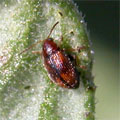TrAINING
Training of grapevines for its growth in desired direction, stature and spread in a way that it is convenient to carry out the operations like pruning, inter-culture, spraying, harvesting etc. This will facilitate sufficient vineyard ventilation, maximum sunlight interception and optimum shade to the ripening bunches, which is important for attaining maximum productivity and quality of berries. Training system depends mainly on the apical dominance and vigour of the vine.
Steps to follow:
•
Allow
all shoots to grow till 50 days
•
Remove week and thin canes and retain only 2-3 strong, healthy shoots
•
Train to bamboo sticks for straight growth
•
Remove lower leaves as shoot matures in batch wise
•
Helps to accumulate food reserves in roots and shoots
Although a number of training systems are known, following two systems
are being followed commercially in India.
1. Y-trellis: In last two decades, this system of training is a major breakthrough in grape cultivation in most of the grape growing regions of India and is becoming very popular in among grape growers who are growing seedless grape varieties. The Y trellis consists of a vertical post of 4 1/2' above the ground and two inclined arms at 110°. The length of each arm is about 4 to 4 1/2'. Four to five wires are drawn at an interval of 9". This system has good provision for light interception and favourable fruit bud formation. When the trellis is covered fully with foliage, both foliage and bunches are protected from sunburn. ‘Y’ trellis is the most suitable training system from the point of view of ease in spraying, hormone treatment, pruning, thinning etc. These trellises have helped largely the mechanization of grape gardens.
2.
Bower system:
Owing to the vigorous growth of the vine and pronounced apical
dominance in the tropics, this system is found most suitable for many
of the commercial grape cultivars in past decades. It envisages the
distribution of growing apex at many points and spread of the
branches horizontally. Among all the training systems, bower is the
most expensive one. Bower of 2.1 m height is erected using granite
stone pillars, galvanized iron wires of 5, 8 and 10-gauge thickness
and turning buckles. Only the best growing shoot from the plant is
allowed to grow upright along the stake provided up to the bower
height and auxiliary shoots are discouraged. Growing tip is pinched
off at 15 cm below the pendal level. Two shoots arising from below
the cut end are allowed to grow in opposite directions on the wires
over-head. These two shoots develop into 'Arms'. Side shoots from
these arms are allowed to grow at regular intervals of 45-50 cm in
dry regions, whereas in comparatively cooler and more humid regions
like Bangalore, they are allowed at intervals of 60-75 cm. These side
shoots develop into 'Secondaries' as they grow. Tertiaries are the
fruiting spurs developing from the secondaries. The arms and
secondaries form the permanent framework of the vine. The area
allocated for a vine is covered in instalments by intermittent
pinching of the primary arms and secondaries, not allowing them to
grow more than 60 cm at a time. At present this system is employed in
areas where varieties such as Bangalore Blue, Gulabi and Dilkush are
cultivated in South Interior Karnataka and Tamil Nadu regions.


